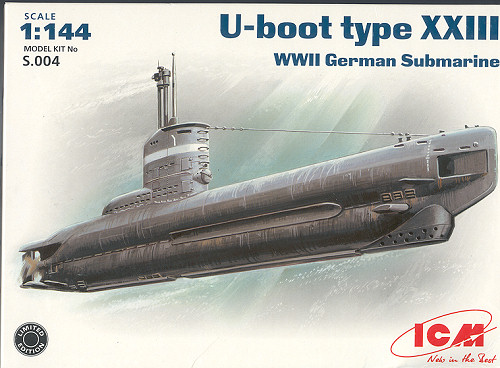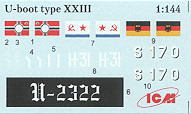
| KIT: | ICM 1/144 Type XXIII U-boat |
| KIT #: | S 004 |
| PRICE: | $22.00 |
| DECALS: | Three options |
| REVIEWER: | Scott Van Aken |
| NOTES: | Looks like new mold to me. |

| HISTORY |
German Type XXIII submarines were designed to operate in the shallows of the North Sea, Black Sea and Mediterranean Sea where larger Type XXI Elektro boats were at risk in World War II. They were so small they could carry only two torpedoes, which had to be loaded externally.
The first Type XXIII, U-2321, was launched from Deutsche Werft in Hamburg on April 17, 1944. It was one of six XXIIIs that went on operational patrol around the British Isles in early 1945. Forty-eight others followed from Deutsche Werft and 13 from Germaniawerft of Kiel. U-4712 was the last one launched, on April 19, 1945.
The first patrol of a Type XXIII began late in the war when U-2324 put to sea on January 29, 1945. U-2336 under the command of Kapitšnleutnant Klusmeier sank the last ships lost in the war, on May 7, when he torpedoed two British freighters inside the Firth of Forth.
None of the six operational Type XXIIIs -- U-2321, U-2322, U-2324, U-2326, U-2329 and U-2336 -- were sunk by the Allies but they sank or damaged five ships for a total of 14,601 tons.
Seven Type XXIIIs were lost to various causes.
In early May 1945, 31 XXIIIs were scuttled by their crews. Twenty surrendered to the Allies and were sunk in Operation Deadlight. Only three -- U-2326 (later British submarine N-35), U-2353 (later British submarine N-37), and U-4706 (later Norwegian submarine Knerten) -- survived the war, Some near completion were transferred to the Soviet Navy as part of war reparations. In 1956, two boats, U-2365 and U-2367 were raised and became the first submarines of the new Federal German Navy.
| THE KIT |
 Seems as if the Type XXIII is a popular subject with Special Hobbies coming out with a 1/72 version; at a rather hefty price, I might add. If you don't want to shell out all the bucks, then this 1/144 version would seem to be a better prospect. The Type XXIII was very much in the mold of a modern submarine that was faster under water than atop it and despite its size, was able to get around rather well.
Seems as if the Type XXIII is a popular subject with Special Hobbies coming out with a 1/72 version; at a rather hefty price, I might add. If you don't want to shell out all the bucks, then this 1/144 version would seem to be a better prospect. The Type XXIII was very much in the mold of a modern submarine that was faster under water than atop it and despite its size, was able to get around rather well.
The ICM kit is about as simple a sub as one can get. The molding on the kit parts is really very nicely done. I didn't find any unwanted ejector pin marks or sink areas on the white plastic. Only a teeny bit of flash on one screw blade. There is a single sprue which consists of the hull halves with the conning tower incorporated into them. The rest of the bits are for the screw, rudder, diving planes fore and aft and the various antennas and periscope and snorkel. Some of the very fine upper deck bits are molded into the hull half and are bound to be trashed during construction. With only about 25 parts, construction should be a piece of cake.
 The instructions are on a single piece of paper with the write-up in Russian and English. A single exploded view is all that is needed for construction and on that same page is a painting diagram. Basic Black and Medium Grey for the sub. A small sheet accompanies the kit with three flags and markings for the conning tower. U-2322 in April of 1945, H-31 of the Soviet Navy in 1947, and S-170 of the Federal German Navy in 1957. The decals are a bit off register and matte with somewhat large clear carrier. No swastika in the center of the WWII Naval Ensign so that will have to be hand painted or come from another source.
The instructions are on a single piece of paper with the write-up in Russian and English. A single exploded view is all that is needed for construction and on that same page is a painting diagram. Basic Black and Medium Grey for the sub. A small sheet accompanies the kit with three flags and markings for the conning tower. U-2322 in April of 1945, H-31 of the Soviet Navy in 1947, and S-170 of the Federal German Navy in 1957. The decals are a bit off register and matte with somewhat large clear carrier. No swastika in the center of the WWII Naval Ensign so that will have to be hand painted or come from another source.
| CONCLUSIONS |
The most widely built types I see in ship categories at shows are submarines. They are generally easy to build and people who normally don't build ships will build a sub. This looks to be a superb kit and one that I really think you should consider.
May 2006
Thanks to  and DLV Company for the review kit. You can find Italeri kits at your favorite hobby shop.
and DLV Company for the review kit. You can find Italeri kits at your favorite hobby shop.
If you would like your product reviewed fairly and quickly by asite that has over 300,000 visitors a month, please contactme or see other details in the